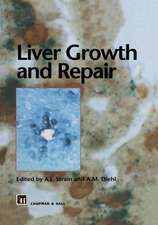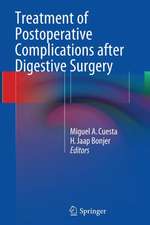Color Atlas of High Resolution Manometry
Editat de Jeffrey Conklin, Mark Pimentel, Edy Sofferen Limba Engleză Paperback – 6 mai 2009
Preț: 1028.06 lei
Preț vechi: 1082.16 lei
-5% Nou
Puncte Express: 1542
Preț estimativ în valută:
196.75€ • 204.65$ • 162.42£
196.75€ • 204.65$ • 162.42£
Carte tipărită la comandă
Livrare economică 14-28 aprilie
Preluare comenzi: 021 569.72.76
Specificații
ISBN-13: 9780387882925
ISBN-10: 0387882928
Pagini: 90
Ilustrații: XII, 90 p. 132 illus., 81 illus. in color.
Dimensiuni: 178 x 254 x 15 mm
Greutate: 0.34 kg
Ediția:2009
Editura: Springer Us
Colecția Springer
Locul publicării:New York, NY, United States
ISBN-10: 0387882928
Pagini: 90
Ilustrații: XII, 90 p. 132 illus., 81 illus. in color.
Dimensiuni: 178 x 254 x 15 mm
Greutate: 0.34 kg
Ediția:2009
Editura: Springer Us
Colecția Springer
Locul publicării:New York, NY, United States
Public țintă
Professional/practitionerCuprins
to High-Resolution Manometry.- Esophageal Manometry.- Gastric/Small Bowel Manometry.- Anorectal Manometry.
Recenzii
From the reviews:
"This atlas depicts the standard manometric tracings of motility derangements in a variety of disease states and then presents the corresponding high resolution manometry (HRM) tracings. … A particular strength of this atlas lies in the detailed illustrations and legends. … This book would be most useful for persons working closely with gastrointestinal diagnostic motility labs, such as nurses, technicians, and the physicians charged with the interpretation of exams. … This will be a useful reference for our esophageal motility lab." (Lisbeth A Selby, Doody’s Review Service, October, 2009)
"This atlas depicts the standard manometric tracings of motility derangements in a variety of disease states and then presents the corresponding high resolution manometry (HRM) tracings. … A particular strength of this atlas lies in the detailed illustrations and legends. … This book would be most useful for persons working closely with gastrointestinal diagnostic motility labs, such as nurses, technicians, and the physicians charged with the interpretation of exams. … This will be a useful reference for our esophageal motility lab." (Lisbeth A Selby, Doody’s Review Service, October, 2009)
Textul de pe ultima copertă
While reflux disease, achalasia, esophageal spasm, gastroparesis and IBS include some of the most common disorders in all disease categories, our understanding of their pathophysiology remains elusive. The field of clinical gastrointestinal motility has for decades relied on the measurement of intraluminal pressures to deduce intestinal movements that define these difficult and enigmatic disorders of gut function. Although computers have greatly facilitated the analysis of data obtained from intraluminal pressure recordings, the sensors and catheters used to measure intraluminal pressures have changed little over the last 20 years.
In the last 3 years, a new technologic breakthrough has taken place in the evaluation of gastrointestinal motor function. It is called high-resolution manometry. Rather than the old 4 to 8 channel conventional systems used to measure intraluminal pressure, high-resolution catheters employ 36 closely spaced, solid state pressure transducers. This technology enhances the resolution of gut motor activity incredibly. By using color to depict pressure, high-resolution color contours are beautiful images that give a detailed spatial and temporal picture of gastrointestinal motor function that was previously impossible. By recognizing motor patterns, diagnoses can be made that are very difficult, if not impossible, to appreciate with the old technology. High-resolution manometry is a dramatic technical leap in a long time stagnant field.
Jeffrey Conklin, MD, is Medical Director, Esophageal Center at Cedars-Sinai Medical Center, Los Angeles, California.
Mark Pimentel, MD, is Director, GI Motility Program, Cedars-Sinai Medical Center, Los Angeles, California.
Edy Soffer, MD, is Co-Director, GI Motility Program, Cedars-Sinai Medical Center, Los Angeles, California.
In the last 3 years, a new technologic breakthrough has taken place in the evaluation of gastrointestinal motor function. It is called high-resolution manometry. Rather than the old 4 to 8 channel conventional systems used to measure intraluminal pressure, high-resolution catheters employ 36 closely spaced, solid state pressure transducers. This technology enhances the resolution of gut motor activity incredibly. By using color to depict pressure, high-resolution color contours are beautiful images that give a detailed spatial and temporal picture of gastrointestinal motor function that was previously impossible. By recognizing motor patterns, diagnoses can be made that are very difficult, if not impossible, to appreciate with the old technology. High-resolution manometry is a dramatic technical leap in a long time stagnant field.
Jeffrey Conklin, MD, is Medical Director, Esophageal Center at Cedars-Sinai Medical Center, Los Angeles, California.
Mark Pimentel, MD, is Director, GI Motility Program, Cedars-Sinai Medical Center, Los Angeles, California.
Edy Soffer, MD, is Co-Director, GI Motility Program, Cedars-Sinai Medical Center, Los Angeles, California.
Caracteristici
All illustrations in color
Only book on high resolution manometry
Only book on high resolution manometry










